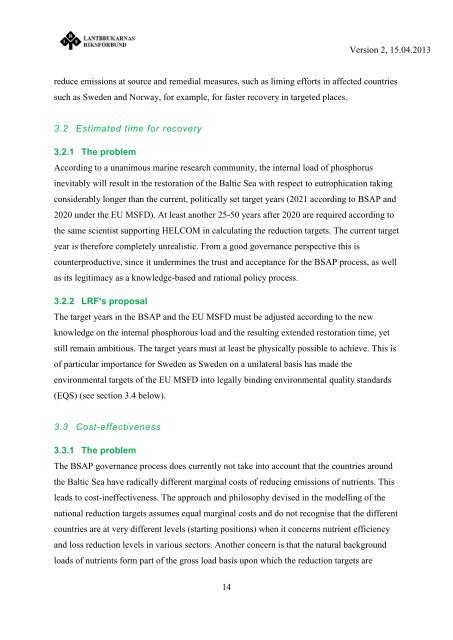LRFrapport_2013015
LRFrapport_2013015
LRFrapport_2013015
You also want an ePaper? Increase the reach of your titles
YUMPU automatically turns print PDFs into web optimized ePapers that Google loves.
14<br />
Version 2, 15.04.2013<br />
reduce emissions at source and remedial measures, such as liming efforts in affected countries<br />
such as Sweden and Norway, for example, for faster recovery in targeted places.<br />
3.2 Estimated time for recovery<br />
3.2.1 The problem<br />
According to a unanimous marine research community, the internal load of phosphorus<br />
inevitably will result in the restoration of the Baltic Sea with respect to eutrophication taking<br />
considerably longer than the current, politically set target years (2021 according to BSAP and<br />
2020 under the EU MSFD). At least another 25-50 years after 2020 are required according to<br />
the same scientist supporting HELCOM in calculating the reduction targets. The current target<br />
year is therefore completely unrealistic. From a good governance perspective this is<br />
counterproductive, since it undermines the trust and acceptance for the BSAP process, as well<br />
as its legitimacy as a knowledge-based and rational policy process.<br />
3.2.2 LRF's proposal<br />
The target years in the BSAP and the EU MSFD must be adjusted according to the new<br />
knowledge on the internal phosphorous load and the resulting extended restoration time, yet<br />
still remain ambitious. The target years must at least be physically possible to achieve. This is<br />
of particular importance for Sweden as Sweden on a unilateral basis has made the<br />
environmental targets of the EU MSFD into legally binding environmental quality standards<br />
(EQS) (see section 3.4 below).<br />
3.3 Cost-effectiveness<br />
3.3.1 The problem<br />
The BSAP governance process does currently not take into account that the countries around<br />
the Baltic Sea have radically different marginal costs of reducing emissions of nutrients. This<br />
leads to cost-ineffectiveness. The approach and philosophy devised in the modelling of the<br />
national reduction targets assumes equal marginal costs and do not recognise that the different<br />
countries are at very different levels (starting positions) when it concerns nutrient efficiency<br />
and loss reduction levels in various sectors. Another concern is that the natural background<br />
loads of nutrients form part of the gross load basis upon which the reduction targets are




